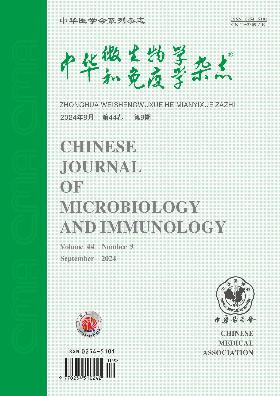培养H7N9禽流感病毒MDCK细胞悬液中TPCK胰蛋白酶添加量的优化
Q4 Immunology and Microbiology
引用次数: 0
摘要
目的研究麦丁-达比犬肾(MDCK)细胞悬液中TPCK胰蛋白酶对H7N9禽流感病毒的最佳培养量。方法在细胞生长和病毒产生过程中加入不同浓度的TPCK胰蛋白酶。每12小时监测一次它们对细胞生长、活力、葡萄糖和乳酸代谢以及血凝滴度的影响。分析批间差异。细胞生长期胰蛋白酶的添加量分别为0、1μg/ml、2μg/ml、4μg/ml、6μg/ml、8μg/ml、10μg/ml和15μg/ml。在病毒产生期间胰蛋白酶的添加量为0、0.5μg/ml、1μg/ml、1.5μg/ml、2μg/ml和2.5μg/ml。当血凝滴度相同时,在0.001、0.005、0.025和0.05的不同感染复数(MOI)下进一步优化添加量。结果TPCK胰蛋白酶浓度对细胞数量、活力、葡萄糖和乳酸代谢没有显著的线性影响。当TPCK胰蛋白酶浓度达到15μg/ml时,未观察到对细胞生长的毒性。接种H7N9禽流感病毒后,1μg/ml、1.5μg/ml、2μg/ml和2.5μg/ml TPCK胰蛋白酶组的血凝滴度在48h达到峰值,为1∶26.5。在60小时时,后两组的血凝滴度比前两组下降得更快。当MOI为0.005时,在相同条件下,1.5μg/ml组48小时的血凝滴度比1μg/ml组的26高26.5。不同批次的TPCK胰蛋白酶存在差异。结论添加1μg/ml和1.5μg/ml的胰蛋白酶能更好地促进H7N9禽流感病毒的增殖,1.5μg/ml胰蛋白酶具有更宽的MOI适用范围。关键词:MDCK细胞;H7N9;Avain流感病毒;TPCK胰蛋白酶;优化研究本文章由计算机程序翻译,如有差异,请以英文原文为准。
Optimization of the amount of TPCK trypsin adding to MDCK cell suspension for culturing H7N9 avian influenza virus
Objective
To investigate the best amount of TPCK trypsin in Madin Darby canine kidney (MDCK) cell suspension for the culture of H7N9 avian influenza virus.
Methods
Different concentrations of TPCK trypsin were added during the periods of cell growth and virus production. Their effects on cell growth, viability, glucose and lactate metabolism, and hemagglutination titer were monitored every 12 h. Inter-batch differences were analyzed. The amount of trypsin added in the cell growth phase was 0, 1 μg/ml, 2 μg/ml, 4 μg/ml, 6 μg/ml, 8 μg/ml, 10 μg/ml and 15 μg/ml. The amount of trypsin added during the virus production period was 0, 0.5 μg/ml, 1 μg/ml, 1.5 μg/ml, 2 μg/ml and 2.5 μg/ml. When the hemagglutination titers were same, the adding amount was further optimized at different multiplicity of infection (MOI) of 0.001, 0.005, 0.025 and 0.05.
Results
No significant linear effects of TPCK trypsin concentration on cell number, viability, and glucose and lactate metabolism were observed. No toxicity to cell growth was observed when TPCK trypsin concentration reached 15 μg/ml. After the inoculation of H7N9 avian influenza virus, the hemagglutination titers in the 1 μg/ml, 1.5 μg/ml, 2 μg/ml and 2.5 μg/ml TPCK trypsin groups reached the peaks at 48 h, which were 1∶26.5. At 60 h, the hemagglutination titers of the latter two groups decreased faster than those of the former two groups. When the MOI was 0.005, the hemagglutination titer of the 1.5 μg/ml group at 48 h was 26.5 higher than 26 in the 1 μg/ml group under the same condition. There were differences between different batches of TPCK trypsin.
Conclusions
Adding 1 μg/ml and 1.5 μg/ml of trypsin could better promote the proliferation of H7N9 avian influenza virus, and 1.5 μg/ml of trypsin had a wider range of MOI applicability.
Key words:
MDCK cells; H7N9; Avain influenza virus; TPCK trypsin; Optimization study
求助全文
通过发布文献求助,成功后即可免费获取论文全文。
去求助
来源期刊

中华微生物学和免疫学杂志
Immunology and Microbiology-Virology
CiteScore
0.50
自引率
0.00%
发文量
6906
期刊介绍:
Chinese Journal of Microbiology and Immunology established in 1981. It is one of the series of journal sponsored by Chinese Medical Association. The aim of this journal is to spread and exchange the scientific achievements and practical experience in order to promote the development of medical microbiology and immunology. Its main contents comprise academic thesis, brief reports, reviews, summaries, news of meetings, book reviews and trends of home and abroad in this field. The distinguishing feature of the journal is to give the priority to the reports on the research of basic theory, and take account of the reports on clinical and practical skills.
 求助内容:
求助内容: 应助结果提醒方式:
应助结果提醒方式:


